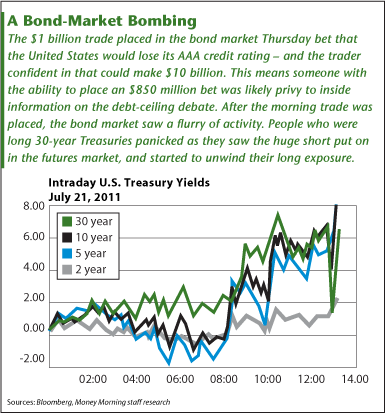The $1 Billion Armageddon Trade Placed Against the United States
BY JACK BARNES, Contributing Writer, Money Morning
Someone dropped a bomb on the bond market Thursday – a $1 billion Armageddon trade betting the United States will lose its AAA credit rating.
In one moment, an invisible trader placed a single trade that moved the most liquid debt market in the world.
The massive trade wasn't placed in bonds themselves; it was placed in the futures market.
The trade was for block trades of 5,370 10-year Treasury futures executed at 124-03 and 3,100 Treasury bond futures executed at 125-01.
The value of the trade was about $850 million dollars. In simple terms, if that was a direct bond buy, no one would be talking about it.
However, with the use of futures, you have to have margin capacity behind the trade. That means with a single push of a button someone was willing to commit more than $1 billion of real capital to this trade with expectations of a 10-to-1 return ratio.
You only do this if you see an edge.
In one moment, an invisible trader placed a single trade that moved the most liquid debt market in the world.
The massive trade wasn't placed in bonds themselves; it was placed in the futures market.
The trade was for block trades of 5,370 10-year Treasury futures executed at 124-03 and 3,100 Treasury bond futures executed at 125-01.
The value of the trade was about $850 million dollars. In simple terms, if that was a direct bond buy, no one would be talking about it.
However, with the use of futures, you have to have margin capacity behind the trade. That means with a single push of a button someone was willing to commit more than $1 billion of real capital to this trade with expectations of a 10-to-1 return ratio.
You only do this if you see an edge.
This means someone is confident that the United States is either going to default or is going to lose its AAA rating. That someone is willing to bet the proverbial farm that U.S. interest rates will be going up.
I believe what happened is a debt-ceiling deal was done in Washington and leaked to a major proprietary trader. Everyone knows the debt negotiations in Washington have been an extreme game of brinksmanship between political parties, but now someone knows how that game played out.
I believe what happened is a debt-ceiling deal was done in Washington and leaked to a major proprietary trader. Everyone knows the debt negotiations in Washington have been an extreme game of brinksmanship between political parties, but now someone knows how that game played out.
This had the hallmarks of one of the largest bond shops in the world knowing something the rest of the market didn't.
The number of shops or even central banks that can take on this level of market risk is extremely small. Some that come to mind are hedge fund manager John Paulson, Bill Gross's PIMCO, and the U.S. and Chinese central banks.
Paulson already scored big – about $6 billion big – on a similar trade years ago when he bet against subprime mortgages, the investments that helped bring down Lehman Bros. and many other investors.
Whoever was behind it wanted a trade on ASAP, and didn't care about the ripples they would cause.

The number of shops or even central banks that can take on this level of market risk is extremely small. Some that come to mind are hedge fund manager John Paulson, Bill Gross's PIMCO, and the U.S. and Chinese central banks.
Paulson already scored big – about $6 billion big – on a similar trade years ago when he bet against subprime mortgages, the investments that helped bring down Lehman Bros. and many other investors.
Whoever was behind it wanted a trade on ASAP, and didn't care about the ripples they would cause.

You can see how this trade caused fear to be unleashed in the market once it got out and the implications hit by looking at U.S. Treasuries. People who were long 30-year Treasuries panicked as they saw the huge short put on the futures market, and started to unwind their long exposure.
What you, as investors, should do now is look at the bond exchange-traded funds (ETFs) that provide a positive rate of return when U.S. Treasuries drop in value. Yields are going up sooner rather than later, if the person behind this Armageddon trade is correct.
News and Related Story Links:
What you, as investors, should do now is look at the bond exchange-traded funds (ETFs) that provide a positive rate of return when U.S. Treasuries drop in value. Yields are going up sooner rather than later, if the person behind this Armageddon trade is correct.
News and Related Story Links:
- Money Morning:
New Poll Says Washington Has Done a Lousy Job During the Debt-Ceiling Debate – But What Do You Think?
- Money Morning:
A Sovereign-Debt-Default Survival Kit: The Four Countries That Will Keep Their AAA Ratings
- Money Morning:
Moody's Warning Edges U.S. Credit Rating Closer to Downgrade
More on this topic (What's this?)Read more on Bond Investing, Credit Ratings Agencies at Wikinvest
Three of the Best Dividend Investments in the World (Investment U, 6/30/11)
8 Ways to Invest Without Buying Stocks (Learn Mining News, 7/16/11)
Ron Paul Suggests Using Fed to End Run Debt Ceiling Impasse (naked capitalism, 7/4/11)
"Can Stocks Be Safer than Bonds?" (Random Roger's Big Picture, 7/6/11)

No comments:
Post a Comment